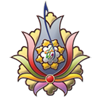Detailes
| ساعت کاربری Man / hours Worked | 1250 |
| تعداد رنگ No. of Colours | 35 |
| تعداد گره در 7 سانتیمتر مربع Knots per 7 cm2 | 1225 |
| رج شمار No. of Rows | 35 |
| عرض سانتی متر Width (cms) | 57 |
| طول سانتی متر Length (cms) | 132 |
The world is nothing, we are nothing Klim
Created by Rasam Arabzadeh
In the 1360s, master painter Arabzadeh designed a painting that expressed the suffering and hardships of the people during the period of the Pahlavi rule until they achieved the government of the Islamic Revolution of Iran.
Pictures of the demonstration scene and chanting of people, the rosary in the hand of a cleric, many question marks in the text of the carpet, the image of a grenade, the bloody boots of the government soldiers, the crying eyes of sad mothers, the bayonets of the weapons of the government soldiers, the leaves of the olive branch (symbol of freedom), the mention of the word why Why why? (What is the cause of all these unfortunate events?), all of them express the ruling policy of the society at that time.
In the middle part of the carpet, there are images of flames, helmets of government soldiers, the face of a cleric who invites people to silence by winking, the image of mothers of martyrs, etc. The layers of society such as ordinary people, workers and clerics, all of whom have passed away, and bloodshot eyes, all of which express the hardships that were imposed on the people of Iran in the time before the revolution.
On the upper part of the carpet, there is a writing line with the title: For what for what? It has been mentioned that it explains why so many problems and hardships should happen.
In the following poems such as: The world is nothing, we are nothing, our imaginations and dreams are twisted. If you knew that I was sleeping, how sad would you be?
One sees the prison of grief, the other sees the garden of Eram. When you woke up, you were neither a prison nor a garden of Eram (Mulan).
The teacher’s purpose in displaying the aforementioned poems and images is to say that all life, whether good or bad, is nothing more than a dream and a fantasy, and it is after death that a person wakes up from real sleep and opens his eyes to the realities of the world.
More Carpet Panels
Created by Rasam Arabzadeh






 A Came of polo Carpet Panel Created by Rasam Arabzadeh Rasam Museum
A Came of polo Carpet Panel Created by Rasam Arabzadeh Rasam Museum (Hafez) Saqinameh Carpet Panel Created by Rasam Arabzadehin in Rasam Museum
(Hafez) Saqinameh Carpet Panel Created by Rasam Arabzadehin in Rasam Museum